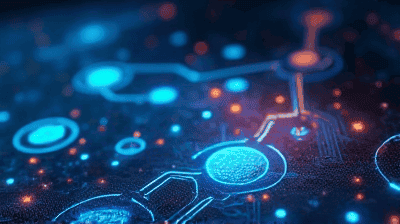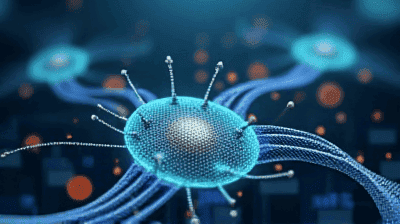The Internet of Bio-Nano Things: How Scientists Are Merging Biology with the IoT

The Internet of Things, or IoT, has already revolutionized numerous industries, from smart homes to healthcare. Now, a new frontier is emerging at the intersection of biology and technology: the Internet of Bio Nano Things, or IoBNT. This innovative field combines nanotechnology and biological systems to create interconnected devices that can communicate, collect data, and perform tasks on a molecular level. The implications of this technology are profound, potentially transforming healthcare, environmental monitoring, and even personal wellness.
Understanding the Internet of Bio Nano Things
What is the Internet of Bio Nano Things?
The Internet of Bio Nano Things refers to a system of devices that integrate biological components with nanotechnology and IoT. These devices, often at the nanoscale, can communicate with each other and transmit data to external systems. This network enables real-time monitoring and control of biological processes, paving the way for advanced applications in various fields, particularly healthcare and environmental science.
The Components of Bio Nano Things
Nanotechnology: This is the manipulation of matter on an atomic, molecular, and supramolecular scale. In the context of IoBNT, nanotechnology allows the creation of extremely small sensors, drug delivery systems, and other devices that can interact with biological systems.
Biological Systems: Biological systems include cells, proteins, and other molecular structures. By interfacing technology with these systems, scientists can create devices that respond to biological stimuli and collect valuable data about living organisms.
IoT Connectivity: The integration of IoT connectivity allows these bio-nanodevices to communicate with each other and send data to cloud-based systems for analysis and processing. This connectivity is crucial for applications requiring real-time data monitoring and response.
Why is IoBNT Important?
The combination of nanotechnology and the IoT holds tremendous potential for advancing multiple fields. Key benefits include:
Real-time Monitoring: IoBNT enables continuous monitoring of biological processes at the cellular or molecular level, providing insights into health and environmental conditions.
Personalized Medicine: By utilizing bio-nanodevices, healthcare professionals can tailor treatments to individual patients based on their unique biological responses.
Environmental Solutions: The ability to monitor and respond to environmental changes in real-time helps address sustainability challenges, enabling better management of natural resources.
Applications of the Internet of Bio Nano Things

1. Healthcare
Disease Detection and Diagnosis
One of the most promising applications of IoBNT lies in disease detection and diagnosis. Nanotechnology can create highly sensitive biosensors capable of detecting low concentrations of biomarkers associated with specific diseases.
Cancer Detection: Researchers have developed nanosensors that can identify cancer-related biomarkers in blood samples, allowing for early diagnosis and treatment. By integrating these sensors with IoT platforms, healthcare providers can receive alerts when abnormal levels are detected.
Infectious Disease Monitoring: IoBNT can facilitate the rapid detection of pathogens, enabling timely responses to infectious disease outbreaks. For example, nanoscale biosensors can detect bacteria or viruses in a patient’s sample and communicate this information to healthcare professionals.
Drug Delivery Systems
Advanced drug delivery systems using bio-nanotechnology are transforming how medications are administered.
Targeted Delivery: Nanocarriers can deliver drugs directly to specific cells or tissues, reducing side effects and increasing treatment efficacy. For instance, drug-loaded nanoparticles can be designed to release their payload in response to specific biological signals.
Smart Nanobots: Researchers are developing programmable nanobots capable of navigating the body and delivering therapeutic agents precisely where needed. These nanobots, connected to IoT systems, can receive real-time data about the body’s conditions and adjust their actions accordingly.
2. Environmental Monitoring
Pollution Detection
IoBNT plays a vital role in monitoring environmental health and addressing pollution.
Water Quality Monitoring: Bio-nanosensors can detect contaminants in water sources, informing authorities and communities about potential hazards. These sensors can continuously monitor water quality and send alerts if pollutant levels exceed safe limits.
Air Quality Assessment: Nanotechnology enables the development of sensors that can detect airborne pollutants and harmful gases. By collecting and transmitting data in real-time, IoBNT can help cities track air quality and implement measures to reduce pollution.
Agricultural Applications
IoBNT can significantly benefit agriculture through improved monitoring and management of crops.
Soil Monitoring: Nanosensors can assess soil health and nutrient levels, providing farmers with insights to optimize crop production. These sensors can relay information about pH levels, moisture content, and the presence of toxins, promoting sustainable farming practices.
Precision Agriculture: By integrating IoBNT into farming equipment, farmers can achieve precision irrigation and fertilization. Devices can monitor crop health and deliver inputs only where needed, reducing waste and enhancing yields.
3. Personal Wellness and Fitness
Wearable Health Devices
The rise of wearable technology is further enhanced by the integration of bio-nanotechnology.
Biometric Monitoring: Devices such as smartwatches and health trackers can incorporate nanosensors to monitor physiological parameters like heart rate, glucose levels, and hydration. These devices can relay data to healthcare providers for proactive care.
Mood and Stress Tracking: Advanced wearables may eventually utilize biosensors to assess stress levels through physiological markers, allowing users to take action to improve their mental well-being.
Smart Fitness Solutions
IoBNT can also contribute to the fitness industry by creating smart equipment that monitors user performance.
Personalized Training: Fitness devices can analyze individual biometrics and suggest exercise regimens tailored to users’ specific needs, enhancing training effectiveness and safety.
Nutritional Guidance: By monitoring dietary habits and metabolic responses, bio-nanosensors can provide personalized nutritional advice, promoting overall health and fitness.
Current Research and Developments
Pioneering Studies
Numerous research initiatives are exploring the vast potential of the Internet of Bio Nano Things.
Nanosensors in Disease Detection
Researchers are developing biosensors that leverage nano-scale materials to improve the sensitivity and specificity of disease detection. For example, scientists have created gold nanoparticles that enhance the detection of cancer biomarkers by amplifying the signal, allowing for earlier diagnosis.
Smart Drug Delivery Systems
Studies are underway to optimize smart nanocarriers for drug delivery. Researchers aim to create nanoparticles that can respond to specific triggers in the body, such as pH changes or temperature, ensuring precise and controlled release of medications.
Collaborative Efforts
Collaboration between academic institutions, private companies, and government organizations is vital for advancing research in the Internet of Bio Nano Things.
Interdisciplinary Teams: Successful IoBNT projects often involve teams of experts from various fields, including biology, materials science, and engineering. This interdisciplinary approach enhances innovation and problem-solving capabilities.
Funding and Grants: Increased investment from governmental and private entities into research initiatives has accelerated advancements in bio-nanotechnology and IoT applications, driving the growth of this exciting field.
Challenges Facing the Internet of Bio Nano Things

Technical Challenges
The integration of biological systems, nanotechnology, and IoT communication presents several technical hurdles.
Miniaturization: Developing nanoscale devices that can operate reliably in biological environments is a complex task. Materials must be compatible with biological systems, and devices must function effectively even at the molecular level.
Energy Supply: Many bio-nanodevices require a continuous power supply to operate. Finding efficient energy sources for these tiny devices remains a significant challenge.
Ethical Considerations
The convergence of biology and technology raises ethical concerns that must be addressed.
Privacy Issues: Wearable bio-nanodevices may collect sensitive health data, leading to potential privacy breaches. Ensuring proper data protection measures are in place is essential for consumer trust.
Bioethical Concerns: The use of nanotechnology in healthcare could lead to ethical dilemmas, particularly concerning modifications to human biology or genetic materials. Careful consideration of these implications is crucial.
Regulatory Hurdles
Navigating the regulatory landscape presents additional challenges for the widespread adoption of IoBNT.
Safety and Efficacy Testing: Establishing safety protocols and efficacy testing for bio-nanodevices is critical before they can be approved for clinical use. The complexity of these devices necessitates rigorous regulatory oversight.
Standardization: The lack of standardized guidelines for the development and deployment of bio-nanotechnology hinders progress. Establishing unified regulations will be crucial for fostering innovation while protecting public health.
The Future of the Internet of Bio Nano Things
Outlook and Predictions
The future of IoBNT is bright, with numerous trends that could shape its development.
Greater Integration with AI: As artificial intelligence continues to advance, its integration with bio-nanotechnology will enhance data analysis and decision-making capabilities. AI algorithms can analyze data collected by IoBNT devices and provide insights for personalized healthcare solutions.
Advancements in Fabrication Techniques: New methods for nanofabrication will enable the creation of more sophisticated and versatile bio-nanodevices. This could lead to the development of multi-functional devices capable of performing a range of tasks within biological systems.
Expanded Applications: As research progresses, the applications of IoBNT are expected to broaden significantly. Potential areas include environmental remediation, food safety monitoring, and advanced biomaterials.
Striving for Sustainability
The Internet of Bio Nano Things also presents opportunities for sustainable practices.
Environmental Conservation: By monitoring environmental conditions and detecting pollutants more efficiently, IoBNT can contribute to more effective conservation efforts and resource management.
Healthcare Efficiency: Personalized medicine and targeted therapies can reduce the overall burden on healthcare systems, promoting more efficient use of resources and minimizing waste.
Educational Initiatives
As the field of IoBNT expands, education will play a crucial role in preparing future generations of scientists, engineers, and healthcare professionals.
Interdisciplinary Education: Educational institutions should prioritize interdisciplinary programs that combine biology, nanotechnology, and information technology, equipping students with the skills needed for the future of IoBNT.
Public Awareness: Raising public awareness of IoBNT and its potential applications will help drive acceptance and understanding of the technology, facilitating its adoption across various sectors.
Conclusion

The Internet of Bio Nano Things represents a groundbreaking intersection of biology and technology. By merging nanotechnology with IoT, scientists are creating devices that can revolutionize healthcare, environmental monitoring, and personal wellness. Despite the challenges of technical complexity, ethical considerations, and regulatory hurdles, the potential benefits of IoBNT are vast.
As research and development continue to advance in this field, the future holds exciting possibilities for transforming how we approach health and environmental challenges. By fostering collaboration, investment, and innovation, we can harness the transformative power of the Internet of Bio Nano Things, ultimately improving the quality of life for individuals and communities worldwide.
